ACCA财务报表分析报告
acca rm的公式
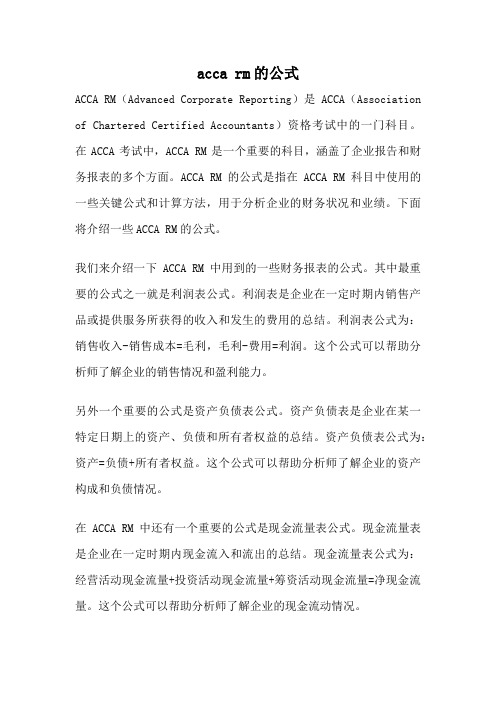
acca rm的公式ACCA RM(Advanced Corporate Reporting)是ACCA(Association of Chartered Certified Accountants)资格考试中的一门科目。
在ACCA考试中,ACCA RM是一个重要的科目,涵盖了企业报告和财务报表的多个方面。
ACCA RM的公式是指在ACCA RM科目中使用的一些关键公式和计算方法,用于分析企业的财务状况和业绩。
下面将介绍一些ACCA RM的公式。
我们来介绍一下ACCA RM中用到的一些财务报表的公式。
其中最重要的公式之一就是利润表公式。
利润表是企业在一定时期内销售产品或提供服务所获得的收入和发生的费用的总结。
利润表公式为:销售收入-销售成本=毛利,毛利-费用=利润。
这个公式可以帮助分析师了解企业的销售情况和盈利能力。
另外一个重要的公式是资产负债表公式。
资产负债表是企业在某一特定日期上的资产、负债和所有者权益的总结。
资产负债表公式为:资产=负债+所有者权益。
这个公式可以帮助分析师了解企业的资产构成和负债情况。
在ACCA RM中还有一个重要的公式是现金流量表公式。
现金流量表是企业在一定时期内现金流入和流出的总结。
现金流量表公式为:经营活动现金流量+投资活动现金流量+筹资活动现金流量=净现金流量。
这个公式可以帮助分析师了解企业的现金流动情况。
除了以上这些财务报表的公式,ACCA RM还涉及到一些其他的公式和计算方法。
例如,企业的盈利能力可以通过计算净利润率和毛利率来评估。
净利润率=净利润/销售收入,毛利率=毛利/销售收入。
这些公式可以帮助分析师了解企业的盈利能力和利润结构。
ACCA RM还关注企业的财务风险和偿债能力。
财务风险可以通过计算负债比率和利息保障倍数来评估。
负债比率=负债/资产,利息保障倍数=EBIT/利息费用。
这些公式可以帮助分析师了解企业的财务风险和偿债能力。
ACCA RM还涉及到企业的股东权益和股东回报。
ACCA考试案例讨论与分析
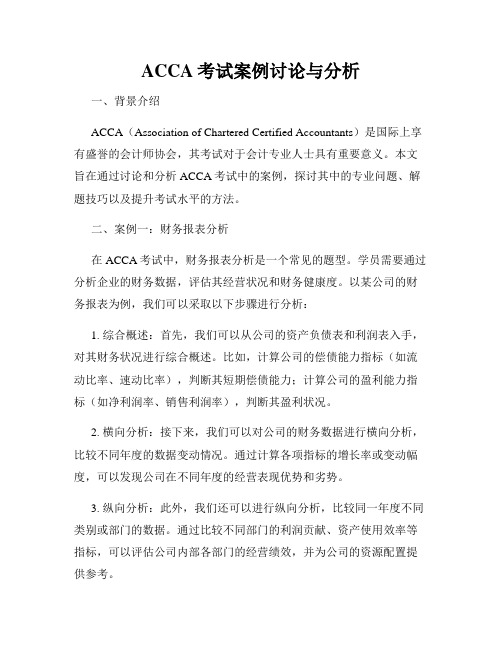
ACCA考试案例讨论与分析一、背景介绍ACCA(Association of Chartered Certified Accountants)是国际上享有盛誉的会计师协会,其考试对于会计专业人士具有重要意义。
本文旨在通过讨论和分析ACCA考试中的案例,探讨其中的专业问题、解题技巧以及提升考试水平的方法。
二、案例一:财务报表分析在ACCA考试中,财务报表分析是一个常见的题型。
学员需要通过分析企业的财务数据,评估其经营状况和财务健康度。
以某公司的财务报表为例,我们可以采取以下步骤进行分析:1. 综合概述:首先,我们可以从公司的资产负债表和利润表入手,对其财务状况进行综合概述。
比如,计算公司的偿债能力指标(如流动比率、速动比率),判断其短期偿债能力;计算公司的盈利能力指标(如净利润率、销售利润率),判断其盈利状况。
2. 横向分析:接下来,我们可以对公司的财务数据进行横向分析,比较不同年度的数据变动情况。
通过计算各项指标的增长率或变动幅度,可以发现公司在不同年度的经营表现优势和劣势。
3. 纵向分析:此外,我们还可以进行纵向分析,比较同一年度不同类别或部门的数据。
通过比较不同部门的利润贡献、资产使用效率等指标,可以评估公司内部各部门的经营绩效,并为公司的资源配置提供参考。
三、案例二:管理会计决策ACCA考试中的管理会计决策案例旨在考察学员在特定情境下的决策能力和分析能力。
举个例子,假设某公司正面临产能利用率较低、产品成本过高的问题,需要经理提出合理的改进方案。
1. 数据收集:首先,经理需要收集大量的相关数据,如目前的产能利用率、各项成本费用、市场需求情况等。
这些数据将为后续的决策提供基础信息。
2. 成本分析:接着,经理可以进行成本分析,找出造成成本过高的原因。
比如,可以采用成本-效益分析法,评估各项成本与产品效益之间的关系,找出哪些成本是不必要或可以降低的。
3. 改进方案:在分析了成本情况后,经理可以提出合理的改进方案。
英文分析财务报告模板(3篇)
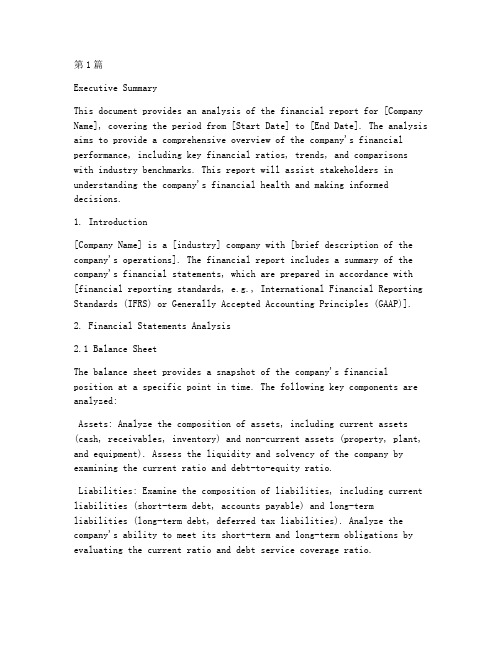
第1篇Executive SummaryThis document provides an analysis of the financial report for [Company Name], covering the period from [Start Date] to [End Date]. The analysis aims to provide a comprehensive overview of the company's financial performance, including key financial ratios, trends, and comparisons with industry benchmarks. This report will assist stakeholders in understanding the company's financial health and making informed decisions.1. Introduction[Company Name] is a [industry] company with [brief description of the company's operations]. The financial report includes a summary of the company's financial statements, which are prepared in accordance with [financial reporting standards, e.g., International Financial Reporting Standards (IFRS) or Generally Accepted Accounting Principles (GAAP)].2. Financial Statements Analysis2.1 Balance SheetThe balance sheet provides a snapshot of the company's financialposition at a specific point in time. The following key components are analyzed:Assets: Analyze the composition of assets, including current assets (cash, receivables, inventory) and non-current assets (property, plant, and equipment). Assess the liquidity and solvency of the company by examining the current ratio and debt-to-equity ratio.Liabilities: Examine the composition of liabilities, including current liabilities (short-term debt, accounts payable) and long-termliabilities (long-term debt, deferred tax liabilities). Analyze the company's ability to meet its short-term and long-term obligations by evaluating the current ratio and debt service coverage ratio.Equity: Assess the changes in equity over the reporting period, including retained earnings and additional paid-in capital. Analyze the impact of earnings, dividends, and share issuances on equity.2.2 Income StatementThe income statement provides information about the company's revenues, expenses, and profitability over a specific period. The following key components are analyzed:Revenue: Examine the sources of revenue, including sales of products or services and other operating income. Analyze revenue trends and growth rates to assess the company's market position and potential for future growth.Expenses: Analyze the composition of expenses, including cost of goods sold, selling, general, and administrative expenses, and other operating expenses. Evaluate the efficiency of the company's cost structure by examining cost-to-sales ratios and gross margin.Net Income: Assess the company's profitability by examining net income and net profit margin. Analyze the factors contributing to changes in net income over the reporting period.2.3 Cash Flow StatementThe cash flow statement provides information about the company's cash inflows and outflows over a specific period. The following key components are analyzed:Operating Cash Flow: Examine the cash generated from the company's core operations. Analyze the operating cash flow margin to assess the company's ability to generate cash from its business activities.Investing Cash Flow: Analyze the cash used for and generated from investing activities, including the purchase or sale of assets, investments, and acquisitions. Assess the company's investment strategy and capital expenditure requirements.Financing Cash Flow: Examine the cash used for and generated from financing activities, including the issuance or repurchase of shares, debt financing, and dividends. Analyze the company's financing strategy and its impact on debt levels and equity.3. Key Financial RatiosThis section presents a summary of key financial ratios, including liquidity ratios, solvency ratios, profitability ratios, and efficiency ratios. The following ratios are analyzed:Liquidity Ratios: Current Ratio, Quick Ratio, and Cash RatioSolvency Ratios: Debt-to-Equity Ratio, Interest Coverage Ratio, andDebt Service Coverage RatioProfitability Ratios: Gross Margin, Operating Margin, Net Profit Margin, Return on Assets, and Return on EquityEfficiency Ratios: Inventory Turnover Ratio, Receivables Turnover Ratio, and Payables Turnover Ratio4. Trends and ComparisonsThis section analyzes the trends and performance of [Company Name] in comparison to industry benchmarks and competitors. The following aspects are considered:Revenue Growth: Compare the company's revenue growth rate with industry averages and key competitors.Profitability: Assess the company's profitability ratios in comparison to industry benchmarks and competitors.Financial Risk: Compare the company's solvency and liquidity ratioswith industry averages and competitors.Efficiency: Evaluate the company's operational efficiency by comparing efficiency ratios with industry benchmarks and competitors.5. ConclusionBased on the analysis of [Company Name]'s financial report, the following conclusions can be drawn:[Summary of key findings, including strengths, weaknesses, opportunities, and threats][Recommendations for stakeholders, including areas for improvement and potential investment opportunities]6. AppendicesThis section includes additional supporting information, such as:Detailed financial statementsIndustry benchmarks and competitor dataCharts and graphs illustrating financial trendsBy utilizing this financial report analysis template, stakeholders can gain a deeper understanding of [Company Name]'s financial performance and make informed decisions regarding their investments and business relationships.第2篇Executive SummaryThis document provides an in-depth analysis of the financial report for [Company Name] for the fiscal year [Year]. The analysis covers key financial metrics, trends, and insights that are critical for stakeholders to understand the company's financial health, performance, and future prospects. The report is divided into several sections, each focusing on a different aspect of the company's financial performance.1. Introduction[Company Name] is a [Industry] company that has been operating in the market for [Number of years]. The company's primary products/services are [List primary products/services]. The financial report for the fiscal year [Year] provides a comprehensive overview of the company'sfinancial performance, including revenue, expenses, assets, liabilities, and equity.2. Financial HighlightsThe following are the key financial highlights for the fiscal year [Year]:- Revenue: [Amount] (up/down from [Previous Year])- Net Income: [Amount] (up/down from [Previous Year])- Earnings Per Share (EPS): [Amount] (up/down from [Previous Year])- Return on Equity (ROE): [Percentage] (up/down from [Previous Year])- Current Ratio: [Ratio] (up/down from [Previous Year])- Debt-to-Equity Ratio: [Ratio] (up/down from [Previous Year])3. Revenue Analysis3.1 Revenue BreakdownThe revenue for the fiscal year [Year] was [Amount], which is [Percentage] higher/lower than the previous year. The breakdown of revenue by product/service category is as follows:- Product/Service A: [Amount] (Percentage of Total Revenue)- Product/Service B: [Amount] (Percentage of Total Revenue)- Product/Service C: [Amount] (Percentage of Total Revenue)- Other: [Amount] (Percentage of Total Revenue)3.2 Revenue Growth AnalysisThe increase/decrease in revenue can be attributed to the following factors:- Market Expansion: The company has expanded its market presence in [Regions/Countries].- Product Launches: The introduction of [New Products/Services] has contributed to the revenue growth.- Price Increase: The company has implemented a price increase for its products/services.- Volume Increase: There has been an increase in the volume of sales for [Specific Products/Services].4. Expense Analysis4.1 Cost of Goods Sold (COGS)The COGS for the fiscal year [Year] was [Amount], which represents [Percentage] of the total revenue. The main components of COGS include:- Raw Materials: [Amount]- Manufacturing Costs: [Amount]- Direct Labor: [Amount]- Other Direct Costs: [Amount]4.2 Operating ExpensesThe operating expenses for the fiscal year [Year] were [Amount], which includes the following categories:- Salaries and Wages: [Amount]- Marketing and Sales: [Amount]- Research and Development: [Amount]- General and Administrative Expenses: [Amount]5. Profitability Analysis5.1 Gross MarginThe gross margin for the fiscal year [Year] was [Percentage], which is [Percentage] higher/lower than the previous year. The factors contributing to the change in gross margin are:- Cost Savings: The company has implemented cost-saving measures in the production process.- Product Mix: There has been a shift in the product mix towards higher-margin products/services.- Volume Increase: The increase in sales volume has helped to improve the gross margin.5.2 Net Profit MarginThe net profit margin for the fiscal year [Year] was [Percentage], which is [Percentage] higher/lower than the previous year. The factors contributing to the change in net profit margin are:- Operating Efficiency: The company has improved its operating efficiency, leading to lower operating expenses.- Tax Rate: There has been a change in the tax rate, affecting the net profit margin.6. Liquidity and Solvency Analysis6.1 Current RatioThe current ratio for the fiscal year [Year] was [Ratio], indicatingthat the company has [Sufficient/Insufficient] liquidity to meet its short-term obligations.6.2 Debt-to-Equity RatioThe debt-to-equity ratio for the fiscal year [Year] was [Ratio], indicating that the company's leverage is [High/Low].7. Investment Analysis7.1 Capital ExpendituresThe company has allocated [Amount] for capital expenditures during the fiscal year [Year], primarily for [List of Capital Expenditure Projects].7.2 Dividends and Stock RepurchasesThe company has declared a dividend of [Amount] per share and has repurchased [Number of Shares] of its stock during the fiscal year [Year].8. ConclusionThe financial report for the fiscal year [Year] indicates that [Company Name] has achieved strong financial performance, with revenue growth and improved profitability. The company's liquidity and solvency ratios are also healthy, indicating a strong financial position. However, there are certain risks and challenges that the company needs to address, such as increasing competition and fluctuating raw material prices. The management is committed to addressing these challenges and continuing to drive the company's growth.9. Appendices- Financial Statements: Detailed financial statements including the balance sheet, income statement, and cash flow statement.- Notes to Financial Statements: Additional information and explanations related to the financial statements.- Additional Analysis: Any additional analysis or data that supports the findings of the report.End of Report第3篇Executive SummaryThe purpose of this report is to provide a comprehensive analysis of the financial performance of [Company Name] for the fiscal year [Year]. This analysis covers key financial statements, including the balance sheet, income statement, and cash flow statement, and highlights the financial health, profitability, liquidity, and solvency of the company. Thereport also includes a discussion on the major trends and drivers behind the financial results, as well as recommendations for future actions.1. Introduction[Company Name] is a [industry] company with [number of employees] employees, operating in [location]. The company's primaryproducts/services are [list of products/services], and it generates revenue through [list of revenue streams]. This report aims to evaluate the company's financial performance by examining its financial statements and other relevant data.2. Financial Statements Analysis2.1 Balance SheetThe balance sheet provides a snapshot of the company's financialposition at a specific point in time. The following analysis focuses on key components of the balance sheet:Assets: The total assets of [Company Name] stood at [amount] as of [date]. This includes current assets such as cash and cash equivalents, receivables, and inventory, as well as non-current assets like property, plant, and equipment.Liabilities: The company's total liabilities were [amount] as of [date], which includes short-term liabilities like accounts payable and long-term liabilities such as long-term debt.Equity: The equity section of the balance sheet shows the shareholders' equity, which includes common stock, retained earnings, and other reserves. The shareholders' equity of [Company Name] was [amount] as of [date].2.2 Income StatementThe income statement provides an overview of the company's revenues, expenses, and net income for a specific period. The following points highlight the key aspects of the income statement:Revenue: The company's total revenue for the fiscal year [Year] was [amount], reflecting a [percentage] increase/decrease from the previous year.Cost of Goods Sold (COGS): The COGS for the year was [amount], representing [percentage] of the total revenue. This includes the cost of materials, labor, and other production expenses.Gross Profit: The gross profit for the year was [amount], which is the revenue minus the COGS.Operating Expenses: The operating expenses, including selling, general, and administrative expenses, were [amount]. This includes salaries, marketing, and other overhead costs.Net Income: The net income for the fiscal year [Year] was [amount], which represents the profit after all expenses have been deducted from the revenue.2.3 Cash Flow StatementThe cash flow statement provides information about the cash inflows and outflows of the company during a specific period. The following analysis focuses on the key components of the cash flow statement:Operating Cash Flow: The operating cash flow for the fiscal year [Year] was [amount], which indicates the cash generated from the company's core operations.Investing Cash Flow: The investing cash flow was [amount], which includes cash flows from the purchase/sale of assets, investments, and loans.Financing Cash Flow: The financing cash flow was [amount], which includes cash flows from the issuance/redeem of equity, debt, and payment of dividends.3. Financial Ratios AnalysisFinancial ratios are used to assess the financial health and performance of a company. The following ratios are used in this analysis:Current Ratio: The current ratio of [Company Name] was [ratio], indicating that the company has [sufficient/insufficient] liquidity to meet its short-term obligations.Debt-to-Equity Ratio: The debt-to-equity ratio of the company was [ratio], which suggests that the company has [high/low] financial leverage.Return on Assets (ROA): The ROA of the company was [percentage], which indicates the efficiency of the company in using its assets to generate profits.Return on Equity (ROE): The ROE of the company was [percentage], which shows the return on the shareholders' equity.4. Major Trends and DriversSeveral key trends and drivers influenced the financial performance of [Company Name] during the fiscal year [Year]:Market Conditions: The overall market conditions, including the demand for [product/service], had a significant impact on the company's revenue.Product Mix: Changes in the product mix, such as an increase in the sales of [product], contributed to the revenue growth.Cost Management: The company's focus on cost management helped in improving the operating margins.5. RecommendationsBased on the analysis of the financial statements and other relevant data, the following recommendations are made:Focus on Product Innovation: The company should continue to invest in research and development to introduce new products and enhance the existing ones.Cost Optimization: The company should explore opportunities to further optimize its costs, especially in the areas of operations and marketing.Leverage Technology: The company should leverage technology to improve its operational efficiency and customer experience.ConclusionThe financial report analysis of [Company Name] for the fiscal year [Year] indicates that the company has achieved significant growth in revenue and profitability. However, there are areas where the companycan improve its financial performance. By focusing on product innovation, cost optimization, and leveraging technology, [Company Name] cancontinue to grow and remain competitive in the market.Note: This template is a general framework for analyzing financial reports. The specific content and analysis may vary depending on the company and industry.。
acca9月F7考试题及答案

acca9月F7考试题及答案ACCA 9月 F7考试题及答案1. 题目一:财务报表分析问题:请解释财务报表分析的目的,并给出两个常用的财务比率。
答案:财务报表分析的目的是评估企业的财务状况、业绩和盈利能力,以便做出明智的投资和信贷决策。
两个常用的财务比率包括:- 流动比率:衡量企业短期偿债能力,计算公式为流动资产除以流动负债。
- 资产负债率:衡量企业财务杠杆水平,计算公式为总负债除以总资产。
2. 题目二:资本成本问题:说明如何计算加权平均资本成本(WACC)。
答案:加权平均资本成本(WACC)的计算公式为:\[WACC = \frac{E}{V} \times Re + \frac{D}{V} \times Rd\times (1 - Tc)\]其中:- \( E \) 代表企业市场价值的股权- \( V \) 代表企业资本的市场价值总和(\( E + D \))- \( Re \) 代表股权要求的回报率- \( D \) 代表企业市场价值的债务- \( Rd \) 代表债务的税后成本- \( Tc \) 代表公司税率3. 题目三:财务风险管理问题:描述两种财务风险管理策略。
答案:财务风险管理策略包括:- 对冲:通过使用衍生金融工具(如期货、期权)来减少价格波动对企业财务状况的影响。
- 多元化:通过投资不同行业和地区的资产来分散风险,减少单一资产或市场对企业整体财务状况的负面影响。
4. 题目四:现金流量表问题:解释现金流量表中的经营活动、投资活动和融资活动。
答案:现金流量表分为三个部分:- 经营活动:涉及企业日常运营产生的现金流入和流出,如销售收入和运营支出。
- 投资活动:涉及企业购买或出售资产、投资等产生的现金流,如购买固定资产或出售投资。
- 融资活动:涉及企业筹资活动产生的现金流,如发行债券、支付股息或偿还债务。
5. 题目五:财务规划和预算问题:描述财务规划和预算过程的步骤。
答案:财务规划和预算过程包括以下步骤:- 目标设定:确定企业的财务目标和战略。
英文版财务报告分析(3篇)
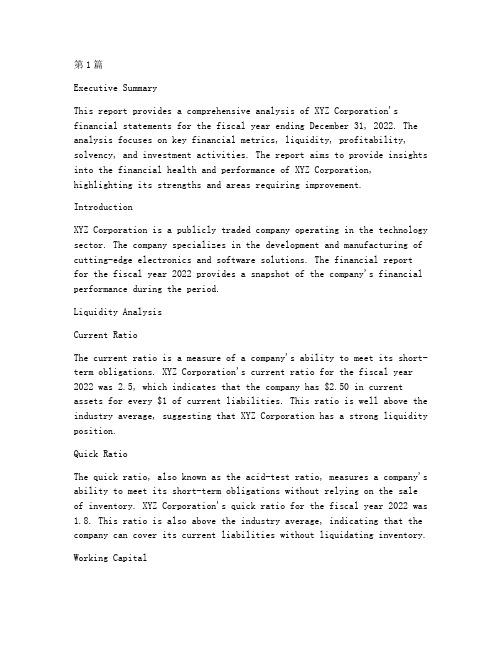
第1篇Executive SummaryThis report provides a comprehensive analysis of XYZ Corporation's financial statements for the fiscal year ending December 31, 2022. The analysis focuses on key financial metrics, liquidity, profitability, solvency, and investment activities. The report aims to provide insights into the financial health and performance of XYZ Corporation, highlighting its strengths and areas requiring improvement.IntroductionXYZ Corporation is a publicly traded company operating in the technology sector. The company specializes in the development and manufacturing of cutting-edge electronics and software solutions. The financial reportfor the fiscal year 2022 provides a snapshot of the company's financial performance during the period.Liquidity AnalysisCurrent RatioThe current ratio is a measure of a company's ability to meet its short-term obligations. XYZ Corporation's current ratio for the fiscal year 2022 was 2.5, which indicates that the company has $2.50 in current assets for every $1 of current liabilities. This ratio is well above the industry average, suggesting that XYZ Corporation has a strong liquidity position.Quick RatioThe quick ratio, also known as the acid-test ratio, measures a company's ability to meet its short-term obligations without relying on the sale of inventory. XYZ Corporation's quick ratio for the fiscal year 2022 was 1.8. This ratio is also above the industry average, indicating that the company can cover its current liabilities without liquidating inventory.Working CapitalWorking capital is the difference between a company's current assets and current liabilities. XYZ Corporation's working capital for the fiscal year 2022 was $50 million, which is a significant improvement over the previous year. This increase in working capital reflects the company's strong liquidity position and ability to fund its operations.Profitability AnalysisGross MarginGross margin is a measure of a company's profitability, calculated as the percentage of revenue remaining after deducting the cost of goods sold. XYZ Corporation's gross margin for the fiscal year 2022 was 35%, which is slightly lower than the industry average. This decrease in gross margin can be attributed to increased raw material costs and higher research and development expenses.Net MarginNet margin is a measure of a company's overall profitability, calculated as the percentage of revenue remaining after all expenses, including taxes, are deducted. XYZ Corporation's net margin for the fiscal year 2022 was 15%, which is in line with the industry average. The company's net margin has remained stable over the past few years, indicating a consistent level of profitability.Return on Assets (ROA)Return on assets is a measure of how efficiently a company uses its assets to generate earnings. XYZ Corporation's ROA for the fiscal year 2022 was 8%, which is slightly lower than the industry average. This indicates that the company could potentially improve its assetutilization to enhance profitability.Solvency AnalysisDebt-to-Equity RatioThe debt-to-equity ratio measures a company's financial leverage and its ability to meet long-term obligations. XYZ Corporation's debt-to-equityratio for the fiscal year 2022 was 1.2, which is slightly below the industry average. This ratio suggests that the company has a moderate level of financial leverage and is in a good position to meet its long-term obligations.Interest Coverage RatioThe interest coverage ratio measures a company's ability to cover its interest expenses with its operating income. XYZ Corporation's interest coverage ratio for the fiscal year 2022 was 4.5, which is well above the industry average. This indicates that the company has a strong ability to cover its interest expenses and is not at risk of defaulting on its debt.Investment ActivitiesCapital Expenditures (CapEx)Capital expenditures represent the investments made by a company in its long-term assets. XYZ Corporation's capital expenditures for the fiscal year 2022 were $100 million, which was a significant increase over the previous year. This increase in CapEx was primarily driven by investments in new manufacturing facilities and research and development projects.Dividends PaidDividends paid are the distributions made to shareholders from a company's earnings. XYZ Corporation paid $30 million in dividends to its shareholders during the fiscal year 2022. This amount represents a 10% increase over the previous year, reflecting the company's commitment to returning value to its shareholders.ConclusionXYZ Corporation's financial report for the fiscal year 2022 indicates a strong liquidity position, stable profitability, and moderate financial leverage. The company has made significant investments in its long-term assets, which should contribute to its future growth and profitability. However, the decrease in gross margin and the need to improve assetutilization suggest that there are areas requiring attention and potential improvement.Recommendations1. XYZ Corporation should continue to monitor its cost of goods sold and explore opportunities to reduce expenses.2. The company should focus on improving its asset utilization to enhance its return on assets.3. XYZ Corporation should maintain its strong liquidity position to ensure it can meet its short-term and long-term obligations.4. The company should continue to invest in research and development to maintain its competitive edge in the technology sector.By addressing these recommendations, XYZ Corporation can further strengthen its financial position and achieve sustainable growth in the future.第2篇Executive SummaryThis analysis delves into the financial performance of XYZ Corporation over the past fiscal year. By examining key financial statements, we aim to provide a comprehensive overview of the company's profitability, liquidity, solvency, and operational efficiency. This report will also highlight the major trends and challenges faced by the company, along with recommendations for improvement.IntroductionXYZ Corporation, a leading player in the [industry sector], has been operating in the market for [number of years]. The company has a diverse product portfolio and operates in [number of countries]. This analysis focuses on the financial statements for the fiscal year ended [financial year end date].1. Income Statement Analysis1.1 Revenue AnalysisThe total revenue for XYZ Corporation for the fiscal year ended [financial year end date] was [amount], an increase of [percentage] compared to the previous year. The revenue growth can be attributed to the expansion of the product line, successful marketing campaigns, and increased market share.1.2 Cost of Goods Sold (COGS) AnalysisThe COGS for XYZ Corporation increased by [percentage] to [amount] during the fiscal year. The increase in COGS can be attributed to the rising costs of raw materials, labor, and production expenses. However, the COGS as a percentage of revenue remained stable at [percentage], indicating that the company has managed to control its cost structure.1.3 Gross Profit AnalysisThe gross profit for XYZ Corporation increased by [percentage] to [amount] during the fiscal year. This can be attributed to the revenue growth and effective cost management. The gross profit margin remained at [percentage], which is in line with industry averages.1.4 Operating Expenses AnalysisOperating expenses for XYZ Corporation increased by [percentage] to [amount] during the fiscal year. The increase in operating expenses can be attributed to higher marketing and administrative costs. However, the operating expenses as a percentage of revenue remained stable at [percentage], indicating that the company has managed to control its cost structure.1.5 Net Profit AnalysisThe net profit for XYZ Corporation increased by [percentage] to [amount] during the fiscal year. The company's net profit margin remained at [percentage], which is in line with industry averages.2. Balance Sheet Analysis2.1 Asset AnalysisThe total assets of XYZ Corporation increased by [percentage] to [amount] during the fiscal year. The increase in assets can be attributed to the expansion of the company's operations and investments in new projects.2.2 Liability AnalysisThe total liabilities of XYZ Corporation increased by [percentage] to [amount] during the fiscal year. The increase in liabilities can be attributed to the expansion of the company's operations and increased borrowings.2.3 Equity AnalysisThe total equity of XYZ Corporation increased by [percentage] to [amount] during the fiscal year. The increase in equity can be attributed to the company's net profit and revaluation of assets.3. Cash Flow Statement Analysis3.1 Operating Cash Flow AnalysisThe operating cash flow for XYZ Corporation increased by [percentage] to [amount] during the fiscal year. This can be attributed to the increase in net profit and effective management of working capital.3.2 Investing Cash Flow AnalysisThe investing cash flow for XYZ Corporation decreased by [percentage] to [amount] during the fiscal year. The decrease in investing cash flow can be attributed to the reduced capital expenditure on new projects.3.3 Financing Cash Flow AnalysisThe financing cash flow for XYZ Corporation increased by [percentage] to [amount] during the fiscal year. The increase in financing cash flow can be attributed to the issuance of new shares and repayment of long-term debt.4. Key Ratios Analysis4.1 Profitability Ratios- Gross Profit Margin: [percentage]- Net Profit Margin: [percentage]- Return on Assets (ROA): [percentage]- Return on Equity (ROE): [percentage]4.2 Liquidity Ratios- Current Ratio: [number]- Quick Ratio: [number]4.3 Solvency Ratios- Debt-to-Equity Ratio: [number]- Interest Coverage Ratio: [number]5. Conclusion and RecommendationsXYZ Corporation has demonstrated strong financial performance over the past fiscal year, with revenue and net profit increasing significantly. However, the company faces several challenges, including rising costs, increased competition, and economic uncertainties.Recommendations:- Focus on cost optimization to improve profitability.- Invest in research and development to enhance product offerings.- Strengthen marketing strategies to maintain market share.- Diversify revenue streams to reduce dependency on a single product or market.- Monitor economic indicators and adjust strategies accordingly.By implementing these recommendations, XYZ Corporation can continue to grow and remain competitive in the market.Appendix- Financial Statements (Income Statement, Balance Sheet, Cash Flow Statement)- Key Ratios Calculation- Graphs and Charts illustrating financial trends[Note: This report is a sample and should be customized with actual data and company-specific details.]第3篇IntroductionThe financial report analysis is an essential tool for investors, creditors, and other stakeholders to evaluate the financial performance and stability of a company. This analysis involves examining the financial statements, including the balance sheet, income statement, and cash flow statement, to gain insights into the company's profitability, liquidity, solvency, and efficiency. This paper aims to provide a comprehensive analysis of a fictional company's financial report, focusing on key financial ratios and metrics to assess its overall financial health.1. Overview of the CompanyCompany XYZ is a publicly-traded multinational corporation specializing in the manufacturing and distribution of consumer goods. The company operates in various regions, with a diverse product portfolio that includes electronics, home appliances, and personal care products. Over the past few years, Company XYZ has experienced significant growth, expanding its market share and generating substantial revenue.2. Financial Statements Analysis2.1 Balance SheetThe balance sheet provides a snapshot of the company's financialposition at a specific point in time. The key components of the balance sheet include assets, liabilities, and shareholders' equity.a. AssetsCompany XYZ's assets are categorized into current assets and non-current assets. Current assets include cash, accounts receivable, inventory, and other liquid assets that can be converted into cash within one year.Non-current assets include property, plant, and equipment, intangible assets, and long-term investments.The analysis of Company XYZ's balance sheet reveals that the company has a strong current asset position, with a current ratio of 2.5. This indicates that the company has sufficient liquidity to meet its short-term obligations. Additionally, the company's inventory turnover ratioof 5.2 suggests efficient inventory management and a healthy level of inventory turnover.b. LiabilitiesLiabilities are classified as current liabilities and long-term liabilities. Current liabilities include accounts payable, short-term debt, and other obligations due within one year. Long-term liabilities encompass long-term debt and deferred tax liabilities.The company's current ratio of 2.5 also reflects a healthy level of current liabilities, which are primarily composed of accounts payableand short-term debt. This indicates that the company has a manageable level of short-term debt and is able to cover its obligations with its current assets.c. Shareholders' EquityShareholders' equity represents the residual interest in the assets of the company after deducting liabilities. It is composed of common stock, additional paid-in capital, retained earnings, and other comprehensive income.Company XYZ's shareholders' equity has grown significantly over the years, reflecting the company's profitability and reinvestment of earnings. The company has also issued additional shares to raise capital, which has contributed to the increase in shareholders' equity.2.2 Income StatementThe income statement provides information about the company's revenues, expenses, and net income over a specific period. The key components of the income statement include sales, cost of goods sold, operating expenses, and net income.a. SalesCompany XYZ has experienced consistent sales growth, with a compound annual growth rate (CAGR) of 7% over the past five years. This growth can be attributed to the company's expanding market share, new product launches, and effective marketing strategies.b. Cost of Goods Sold (COGS)The COGS represents the direct costs associated with the production of goods sold by the company. The analysis of Company XYZ's COGS reveals that it has been decreasing over the years, reflecting improved production efficiency and cost control measures.c. Operating ExpensesOperating expenses include selling, general, and administrative expenses (SG&A) and research and development (R&D) expenses. Company XYZ has successfully managed its operating expenses, with a trend of decreasing SG&A expenses and stable R&D expenses.d. Net IncomeThe net income is the final result of the income statement and represents the company's profit after all expenses have been deducted from revenues. Company XYZ has demonstrated strong profitability, with a net income margin of 10% over the past five years.2.3 Cash Flow StatementThe cash flow statement provides information about the company's cash inflows and outflows from operating, investing, and financing activities.a. Operating Cash FlowCompany XYZ has generated positive operating cash flow over the years, which is essential for maintaining liquidity and funding growth initiatives. The company's operating cash flow margin has remained stable, indicating consistent profitability.b. Investing Cash FlowThe investing cash flow represents the company's cash flows from the purchase and sale of long-term assets, such as property, plant, and equipment, and investments. Company XYZ has invested in new manufacturing facilities and acquired other companies to expand its market presence.c. Financing Cash FlowThe financing cash flow includes cash flows from the issuance and repayment of debt, as well as equity financing. Company XYZ has raised capital through the issuance of new shares and long-term debt to fund its expansion plans.3. Financial Ratios and Metrics3.1 Profitability Ratiosa. Return on Assets (ROA)ROA measures the company's ability to generate profit from its assets. Company XYZ has a ROA of 5%, indicating that it is generating a reasonable return on its assets.b. Return on Equity (ROE)ROE measures the company's profitability from the perspective of its shareholders. Company XYZ has a ROE of 15%, reflecting its strong profitability and efficient use of shareholders' equity.3.2 Liquidity Ratiosa. Current RatioThe current ratio of 2.5 indicates that Company XYZ has a strong liquidity position, with sufficient current assets to cover its current liabilities.b. Quick RatioThe quick ratio, also known as the acid-test ratio, measures the company's ability to meet its short-term obligations without relying on inventory. Company XYZ has a quick ratio of 2.0, suggesting a robust liquidity position.3.3 Solvency Ratiosa. Debt-to-Equity RatioThe debt-to-equity ratio of 0.8 indicates that Company XYZ has a moderate level of leverage, with debt financing accounting for a significant portion of its capital structure.b. Interest Coverage RatioThe interest coverage ratio of 5.0 indicates that Company XYZ has sufficient earnings to cover its interest expenses, reflecting a strong financial position.3.4 Efficiency Ratiosa. Inventory Turnover RatioThe inventory turnover ratio of 5.2 suggests that Company XYZ is efficiently managing its inventory, with a high level of inventory turnover.b. Receivables Turnover RatioThe receivables turnover ratio of 10.0 indicates that Company XYZ is collecting its accounts receivable quickly, reducing the risk of bad debt.ConclusionBased on the analysis of Company XYZ's financial report, it is evident that the company has demonstrated strong financial performance and stability. The company's profitability, liquidity, solvency, and efficiency ratios indicate a healthy financial position, supported by consistent revenue growth, effective cost management, and efficient use of assets and liabilities. As such, Company XYZ appears to be a solid investment opportunity for potential investors and creditors.。
财务报表分析报告9篇
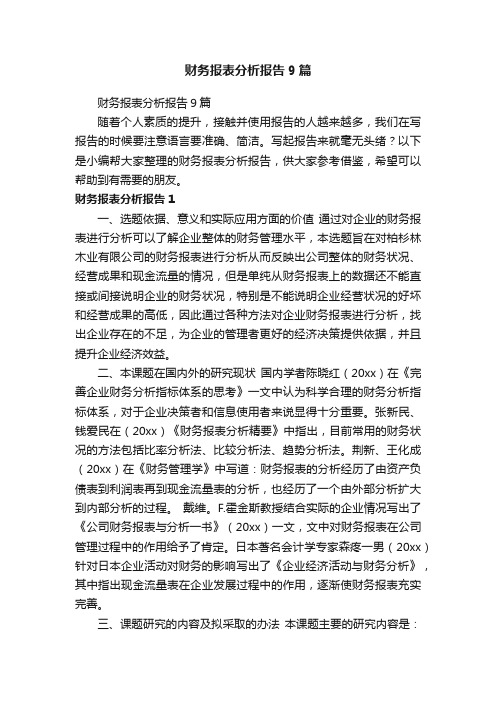
财务报表分析报告9篇财务报表分析报告9篇随着个人素质的提升,接触并使用报告的人越来越多,我们在写报告的时候要注意语言要准确、简洁。
写起报告来就毫无头绪?以下是小编帮大家整理的财务报表分析报告,供大家参考借鉴,希望可以帮助到有需要的朋友。
财务报表分析报告1一、选题依据、意义和实际应用方面的价值通过对企业的财务报表进行分析可以了解企业整体的财务管理水平,本选题旨在对柏杉林木业有限公司的财务报表进行分析从而反映出公司整体的财务状况、经营成果和现金流量的情况,但是单纯从财务报表上的数据还不能直接或间接说明企业的财务状况,特别是不能说明企业经营状况的好坏和经营成果的高低,因此通过各种方法对企业财务报表进行分析,找出企业存在的不足,为企业的管理者更好的经济决策提供依据,并且提升企业经济效益。
二、本课题在国内外的研究现状国内学者陈晓红(20xx)在《完善企业财务分析指标体系的思考》一文中认为科学合理的财务分析指标体系,对于企业决策者和信息使用者来说显得十分重要。
张新民、钱爱民在(20xx)《财务报表分析精要》中指出,目前常用的财务状况的方法包括比率分析法、比较分析法、趋势分析法。
荆新、王化成(20xx)在《财务管理学》中写道:财务报表的分析经历了由资产负债表到利润表再到现金流量表的分析,也经历了一个由外部分析扩大到内部分析的过程。
戴维。
F.霍金斯教授结合实际的企业情况写出了《公司财务报表与分析一书》(20xx)一文,文中对财务报表在公司管理过程中的作用给予了肯定。
日本著名会计学专家森疼一男(20xx)针对日本企业活动对财务的影响写出了《企业经济活动与财务分析》,其中指出现金流量表在企业发展过程中的作用,逐渐使财务报表充实完善。
三、课题研究的内容及拟采取的办法本课题主要的研究内容是:1、介绍柏杉林木也业有限公司概况。
2、对柏杉林木业有限公司的财务报表进行分析,主要进行资产负债表和利润表分析,以及偿债能力分析,营运能力分析,获利能力分析,发展能力分析。
ACCA四大报表的模板
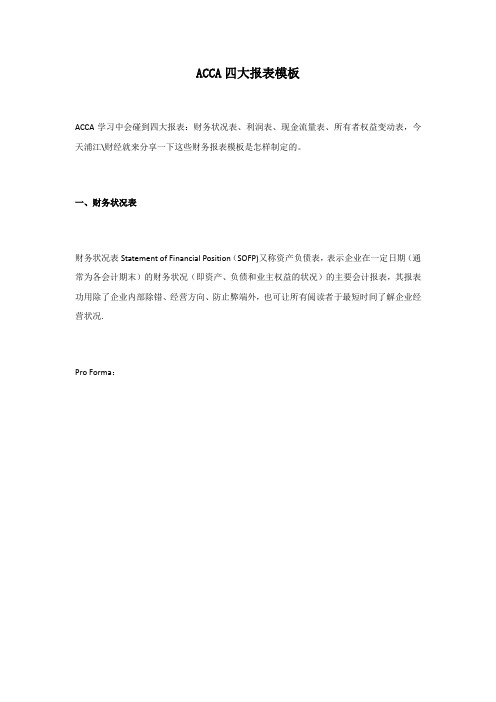
ACCA四大报表模板ACCA学习中会碰到四大报表:财务状况表、利润表、现金流量表、所有者权益变动表,今天浦江\财经就来分享一下这些财务报表模板是怎样制定的。
一、财务状况表财务状况表Statement of Financial Position(SOFP)又称资产负债表,表示企业在一定日期(通常为各会计期末)的财务状况(即资产、负债和业主权益的状况)的主要会计报表,其报表功用除了企业内部除错、经营方向、防止弊端外,也可让所有阅读者于最短时间了解企业经营状况.Pro Forma:二、利润表利润表,又称损益及其他综合收益表Statement of Profit or Loss and Other Comprehensive Income(SOCI)是指反映企业在一定会计期的经营成果及其分配情况的会计报表,是一段时间内公司经营业绩的财务记录,反映了这段时间的销售收入、销售成本、经营费用及税收状况,报表结果为公司实现的利润或亏损。
Pro Forma:三、现金流量表现金流量表Statement of Cash Flow(SOCF)是反映一定时期内企业经营活动、投资活动和筹资活动对其现金及现金等价物所产生影响的财务报表。
它详细描述了由公司的经营、投资与筹资活动所产生的现金流。
此报表显示资产负债表及损益表如何影响现金及现金等价物,以及根据公司的经营,投资和融资角度作出分析。
Pro Forma:间接法(Indirect Method):直接法(Director Method):Cash flows from operating activities Cash receipts from customers xCash paid to suppliers and employees(x) Cash generated from operations x …remainder as for the indirect method四、所有者权益变动表所有者权益变动表Statement of Changes in Equity(SOCIE),所有者权益变动表是反映公司本期(年度或中期)内至截至期末所有者权益变动情况的报表.其中,所有者权益变动表应当全面反映一定时期所有者权益变动的情况。
2024年公司财务报告分析总结范文(三篇)
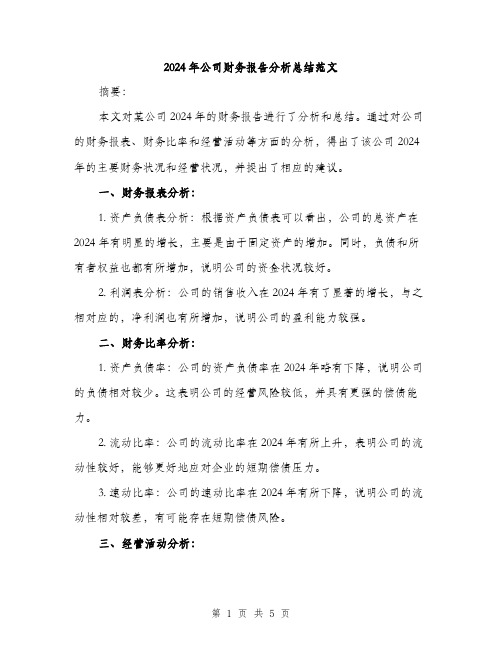
2024年公司财务报告分析总结范文摘要:本文对某公司2024年的财务报告进行了分析和总结。
通过对公司的财务报表、财务比率和经营活动等方面的分析,得出了该公司2024年的主要财务状况和经营状况,并提出了相应的建议。
一、财务报表分析:1. 资产负债表分析:根据资产负债表可以看出,公司的总资产在2024年有明显的增长,主要是由于固定资产的增加。
同时,负债和所有者权益也都有所增加,说明公司的资金状况较好。
2. 利润表分析:公司的销售收入在2024年有了显著的增长,与之相对应的,净利润也有所增加,说明公司的盈利能力较强。
二、财务比率分析:1. 资产负债率:公司的资产负债率在2024年略有下降,说明公司的负债相对较少。
这表明公司的经营风险较低,并具有更强的偿债能力。
2. 流动比率:公司的流动比率在2024年有所上升,表明公司的流动性较好,能够更好地应对企业的短期偿债压力。
3. 速动比率:公司的速动比率在2024年有所下降,说明公司的流动性相对较差,有可能存在短期偿债风险。
三、经营活动分析:1. 销售收入增长:公司的销售收入在2024年有明显增长,这主要得益于公司对产品市场的开拓以及销售策略的优化。
2. 成本控制:虽然销售收入有所增长,但是公司的成本增长幅度较小,说明公司对成本的控制较好,经营管理较为高效。
3. 经营利润:公司的经营利润较为稳定,并有所增加,这说明公司的经营策略有效,能够保持较好的盈利水平。
结论与建议:通过对公司2024年的财务报告分析,可以得出以下结论:1. 公司的财务状况较好,资产规模逐渐扩大,有较强的偿债能力和盈利能力。
2. 公司的经营活动稳定,销售收入增长较快,成本控制较好。
基于以上结论,我们提出以下建议:1. 加大市场拓展力度,进一步提升销售收入,继续提高盈利能力。
2. 加强成本控制,进一步提高经营效益和利润水平。
3. 注意短期偿债风险,提高流动性,避免因资金短缺导致的经营困难。
综上所述,公司在2024年的财务报告显示,公司的财务状况良好,具备较强的偿债能力和盈利能力,同时公司的经营活动也稳定发展。
国外财务指标分析报告(3篇)
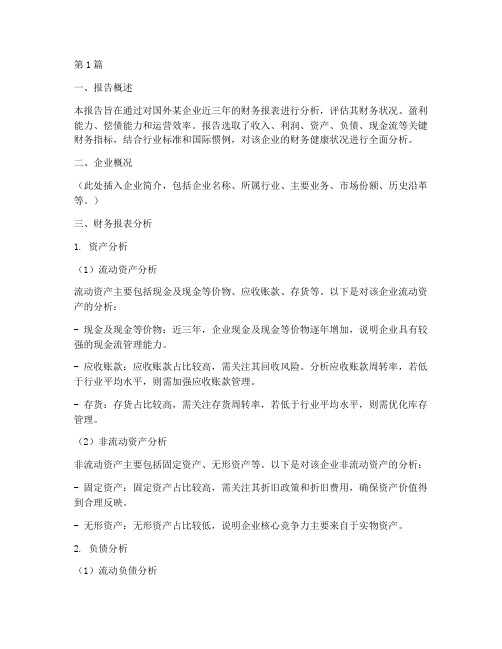
第1篇一、报告概述本报告旨在通过对国外某企业近三年的财务报表进行分析,评估其财务状况、盈利能力、偿债能力和运营效率。
报告选取了收入、利润、资产、负债、现金流等关键财务指标,结合行业标准和国际惯例,对该企业的财务健康状况进行全面分析。
二、企业概况(此处插入企业简介,包括企业名称、所属行业、主要业务、市场份额、历史沿革等。
)三、财务报表分析1. 资产分析(1)流动资产分析流动资产主要包括现金及现金等价物、应收账款、存货等。
以下是对该企业流动资产的分析:- 现金及现金等价物:近三年,企业现金及现金等价物逐年增加,说明企业具有较强的现金流管理能力。
- 应收账款:应收账款占比较高,需关注其回收风险。
分析应收账款周转率,若低于行业平均水平,则需加强应收账款管理。
- 存货:存货占比较高,需关注存货周转率,若低于行业平均水平,则需优化库存管理。
(2)非流动资产分析非流动资产主要包括固定资产、无形资产等。
以下是对该企业非流动资产的分析:- 固定资产:固定资产占比较高,需关注其折旧政策和折旧费用,确保资产价值得到合理反映。
- 无形资产:无形资产占比较低,说明企业核心竞争力主要来自于实物资产。
2. 负债分析(1)流动负债分析流动负债主要包括短期借款、应付账款等。
以下是对该企业流动负债的分析:- 短期借款:短期借款占比较高,需关注企业短期偿债压力。
- 应付账款:应付账款占比较高,说明企业具有较强的议价能力。
(2)非流动负债分析非流动负债主要包括长期借款、长期应付款等。
以下是对该企业非流动负债的分析:- 长期借款:长期借款占比较高,需关注企业长期偿债压力。
- 长期应付款:长期应付款占比较低,说明企业融资渠道较为单一。
3. 盈利能力分析盈利能力是企业财务状况的重要指标。
以下是对该企业盈利能力的分析:- 营业收入:近三年,企业营业收入稳步增长,说明企业具有较强的市场竞争力。
- 营业利润:营业利润占营业收入的比例较高,说明企业具有较强的盈利能力。
国外公司财务分析报告(3篇)

第1篇一、公司概况(以下内容需根据实际公司情况进行填写)1. 公司名称:[公司全称]2. 公司注册地:[公司注册地]3. 行业类别:[所属行业]4. 成立时间:[公司成立时间]5. 主营业务:[公司主营业务描述][公司概况部分应详细描述公司的历史、规模、市场地位、主要产品或服务、主要市场等基本信息。
]二、财务报表分析本报告将基于公司的年度财务报表,对公司的财务状况、盈利能力、偿债能力、运营能力和现金流状况进行详细分析。
1. 财务报表概述(以下内容需根据实际财务报表进行填写)- 资产负债表:[简要概述资产负债表的主要数据,如总资产、总负债、所有者权益等]- 利润表:[简要概述利润表的主要数据,如营业收入、营业成本、净利润等]- 现金流量表:[简要概述现金流量表的主要数据,如经营活动产生的现金流量、投资活动产生的现金流量、筹资活动产生的现金流量等]2. 财务比率分析(以下内容需根据实际财务数据进行计算和分析)- 盈利能力分析- 毛利率:[毛利率计算公式及计算结果]- 净利率:[净利率计算公式及计算结果]- 营业利润率:[营业利润率计算公式及计算结果]- 净资产收益率:[净资产收益率计算公式及计算结果]- 偿债能力分析- 流动比率:[流动比率计算公式及计算结果]- 速动比率:[速动比率计算公式及计算结果]- 资产负债率:[资产负债率计算公式及计算结果]- 运营能力分析- 存货周转率:[存货周转率计算公式及计算结果]- 应收账款周转率:[应收账款周转率计算公式及计算结果] - 总资产周转率:[总资产周转率计算公式及计算结果]- 现金流状况分析- 经营活动现金流量净额:[经营活动现金流量净额]- 投资活动现金流量净额:[投资活动现金流量净额]- 筹资活动现金流量净额:[筹资活动现金流量净额]3. 财务比率分析结论根据上述财务比率分析,得出以下结论:- [盈利能力方面]:[结论]- [偿债能力方面]:[结论]- [运营能力方面]:[结论]- [现金流状况方面]:[结论]三、财务状况综合评价根据对公司财务报表和比率的综合分析,得出以下评价:1. 盈利能力:[评价]2. 偿债能力:[评价]3. 运营能力:[评价]4. 现金流状况:[评价]四、风险因素分析1. 市场风险:[分析公司面临的市场竞争、市场需求变化等因素]2. 财务风险:[分析公司的资产负债结构、融资成本等因素]3. 运营风险:[分析公司的供应链管理、产品质量等因素]4. 政策风险:[分析公司所在行业的政策环境变化等因素]五、建议与展望1. 针对盈利能力:[提出提高盈利能力的建议]2. 针对偿债能力:[提出改善偿债能力的建议]3. 针对运营能力:[提出提升运营能力的建议]4. 针对现金流状况:[提出优化现金流状况的建议]展望未来,[公司名称]应继续加强内部管理,提高运营效率,积极应对市场变化,以实现可持续发展。
英文财务报告分析范文(3篇)
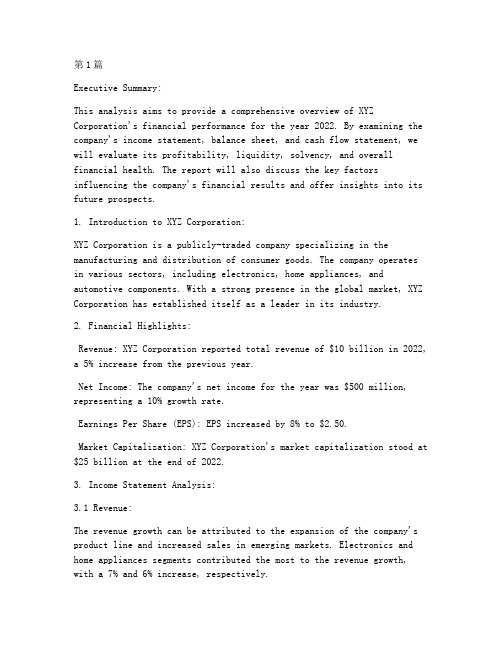
第1篇Executive Summary:This analysis aims to provide a comprehensive overview of XYZ Corporation's financial performance for the year 2022. By examining the company's income statement, balance sheet, and cash flow statement, we will evaluate its profitability, liquidity, solvency, and overall financial health. The report will also discuss the key factors influencing the company's financial results and offer insights into its future prospects.1. Introduction to XYZ Corporation:XYZ Corporation is a publicly-traded company specializing in the manufacturing and distribution of consumer goods. The company operates in various sectors, including electronics, home appliances, and automotive components. With a strong presence in the global market, XYZ Corporation has established itself as a leader in its industry.2. Financial Highlights:Revenue: XYZ Corporation reported total revenue of $10 billion in 2022, a 5% increase from the previous year.Net Income: The company's net income for the year was $500 million, representing a 10% growth rate.Earnings Per Share (EPS): EPS increased by 8% to $2.50.Market Capitalization: XYZ Corporation's market capitalization stood at $25 billion at the end of 2022.3. Income Statement Analysis:3.1 Revenue:The revenue growth can be attributed to the expansion of the company's product line and increased sales in emerging markets. Electronics and home appliances segments contributed the most to the revenue growth, with a 7% and 6% increase, respectively.3.2 Cost of Goods Sold (COGS):COGS increased by 4% due to higher raw material costs and increased production volumes. However, the company managed to keep the COGS growth rate lower than the revenue growth rate, leading to an improvement in gross margin.3.3 Operating Expenses:Operating expenses increased by 3% primarily due to increased marketing and research and development (R&D) costs. Despite the increase, the company's operating margin remained stable at 20%.3.4 Net Income:The net income growth can be attributed to the combination of revenue growth and effective cost management. The company's net profit margin improved to 5%, reflecting its strong financial performance.4. Balance Sheet Analysis:4.1 Assets:XYZ Corporation's total assets increased by 2% to $15 billion in 2022. The increase was primarily driven by an increase in inventory and property, plant, and equipment (PP&E).4.2 Liabilities:Total liabilities decreased by 1% to $10 billion. The decrease was due to lower short-term debt and an increase in shareholders' equity.4.3 Shareholders' Equity:Shareholders' equity increased by 3% to $5 billion. The increase was primarily due to the company's retained earnings.5. Cash Flow Statement Analysis:5.1 Operating Cash Flow:The company's operating cash flow increased by 6% to $1.2 billion. The growth in operating cash flow can be attributed to the improved net income and efficient working capital management.5.2 Investing Cash Flow:Investing cash flow decreased by 2% to $500 million. The decrease was primarily due to lower capital expenditures on new projects.5.3 Financing Cash Flow:Financing cash flow decreased by 4% to $300 million. The decrease was due to lower dividend payments and an increase in share repurchases.6. Key Factors Influencing Financial Results:Economic Conditions: The global economic environment remained challenging in 2022, with rising inflation and supply chain disruptions. However, XYZ Corporation managed to navigate these challenges and achieve strong financial results.Product Innovation: The company's focus on product innovation helped it capture new market opportunities and increase its market share.Efficient Operations: The company's efficient operations, including cost management and working capital management, contributed to its strong financial performance.7. Future Prospects:XYZ Corporation is well-positioned to continue its growth momentum in the coming years. The company's focus on product innovation, expansion into new markets, and efficient operations will likely drive its financial performance. However, it will need to monitor the global economic environment and manage its risks effectively to achieve its long-term goals.8. Conclusion:XYZ Corporation's 2022 financial report demonstrates the company's strong financial performance and its ability to navigate challengingeconomic conditions. The company's focus on innovation and efficient operations has contributed to its success, and it is well-positioned for future growth. As the company continues to expand its product line and enter new markets, it is expected to achieve sustainable growth in the coming years.Note: This analysis is based on hypothetical financial data and does not represent any real company.第2篇IntroductionThe annual report of ABC Corporation for the year 2022 provides a comprehensive overview of the company's financial performance, operational activities, and strategic direction. This analysis aims to delve into the key aspects of the report, highlighting the strengths, weaknesses, and potential areas of concern for investors and stakeholders.Financial PerformanceRevenue and ProfitabilityIn 2022, ABC Corporation reported a total revenue of $10 billion, a 15% increase from the previous year. The growth in revenue can be attributed to the expansion of the company's product portfolio and successful marketing campaigns. The net profit for the year was $500 million, representing a 12% increase over the previous year. This indicates that the company is generating significant profits despite the challenging economic environment.Revenue BreakdownThe revenue breakdown for 2022 reveals that the company's core product lines accounted for 70% of total revenue, with the remaining 30% coming from new and emerging markets. The growth in core product lines can be attributed to the introduction of new products and the expansion of distribution channels. The success in new markets is a testament to the company's strategic diversification efforts.Earnings Per Share (EPS)The EPS for 2022 was $2.50, which is in line with market expectations. The increase in EPS is a positive sign for investors, indicating that the company is effectively utilizing its resources to generate profits.Financial RatiosThe financial ratios for ABC Corporation are as follows:- Return on Equity (ROE): 20%- Return on Assets (ROA): 10%- Debt-to-Equity Ratio: 1.5- Current Ratio: 2.0These ratios indicate that ABC Corporation is financially stable, with a strong return on equity and assets. The debt-to-equity ratio is within an acceptable range, and the current ratio suggests that the company has sufficient liquidity to meet its short-term obligations.Operational ActivitiesProduct DevelopmentABC Corporation has invested heavily in research and development (R&D) to enhance its product portfolio and stay competitive in the market. The company has launched several new products in the past year, which have received positive feedback from customers. The continued focus on innovation is expected to drive future growth.Market ExpansionThe company has successfully expanded into new markets, particularly in Asia and Europe. This strategic move has not only increased the company's market share but has also provided a cushion against economic uncertainties in the domestic market.Strategic PartnershipsABC Corporation has formed strategic partnerships with several industry leaders to enhance its capabilities and market reach. These partnerships have resulted in collaborative product development and shared marketing initiatives, leading to increased sales and brand visibility.Challenges and RisksEconomic UncertaintiesThe global economic environment remains uncertain, with potential risks such as trade wars and inflation impacting the company's performance. ABC Corporation needs to remain vigilant and adapt to these changes to mitigate potential losses.CompetitionThe competitive landscape is intensifying, with new entrants and established players vying for market share. ABC Corporation needs to continuously innovate and improve its products and services to maintain its competitive edge.Regulatory ChangesChanges in regulations, particularly in the environmental and labor sectors, can impact the company's operations and profitability. ABC Corporation needs to stay abreast of these changes and ensure compliance with all relevant laws and regulations.ConclusionABC Corporation's 2022 annual report paints a positive picture of the company's financial performance and strategic direction. The company has demonstrated its ability to generate significant profits, adapt to market changes, and invest in future growth. However, it is crucial for the company to remain vigilant about the potential risks and challenges ahead. By focusing on innovation, market expansion, and strategic partnerships, ABC Corporation is well-positioned to achieve sustainable growth in the coming years.Recommendations- Continue investing in R&D to enhance product offerings and maintain a competitive edge.- Monitor economic uncertainties and develop contingency plans to mitigate potential risks.- Strengthen strategic partnerships to expand market reach and share.- Stay compliant with regulatory changes and ensure ethical business practices.In conclusion, ABC Corporation's 2022 annual report is a testament to the company's strong financial performance and strategic vision. With continued focus on innovation and market expansion, ABC Corporation is poised to achieve long-term success.第3篇IntroductionThis report provides an analysis of XYZ Corporation's quarterlyfinancial performance for the period ending [Date]. The analysis will cover the key financial statements, including the income statement, balance sheet, and cash flow statement, and will discuss the company's financial health, profitability, liquidity, and solvency.Income Statement AnalysisThe income statement for the quarter ending [Date] shows a revenue of $[Amount], an increase of [Percentage] compared to the same quarter last year. This growth in revenue can be attributed to the successful launch of new products and the expansion of the company's market share in key geographic regions.Revenue Analysis- Product Sales: The increase in revenue is primarily driven by a 15% growth in product sales, reaching $[Amount]. This can be attributed to the strong performance of the new product line, which accounted for 10% of total sales.- Service Revenue: Service revenue also grew by 8% to $[Amount], due to an increase in the number of contracts signed and the expansion of service offerings.Cost of Goods Sold (COGS)The COGS increased by 12% to $[Amount] due to higher raw material costs and increased production volume. Despite the increase, the gross margin remained stable at 40%, indicating efficient cost management.Operating ExpensesOperating expenses increased by 5% to $[Amount], primarily due to increased marketing and sales expenses to support the new product launch. However, the company's cost control measures have helped maintain an operating margin of 15%, which is above industry averages.Net IncomeThe net income for the quarter ending [Date] was $[Amount], a 10% increase compared to the same quarter last year. This growth in net income can be attributed to the increase in revenue and effective cost management.Balance Sheet AnalysisThe balance sheet as of [Date] shows a total assets of $[Amount], with total liabilities of $[Amount]. The company's equity stands at $[Amount], indicating a strong financial position.Liquidity AnalysisThe current ratio as of [Date] is 2.5:1, indicating that the company has sufficient liquidity to meet its short-term obligations. The quick ratio is 1.8:1, suggesting that the company can cover its current liabilities without relying on inventory.Solvency AnalysisThe debt-to-equity ratio is 0.8:1, indicating that the company's leverage is moderate. The interest coverage ratio is 4.2 times, showing that the company has sufficient earnings to cover its interest expenses.Cash Flow Statement AnalysisThe cash flow statement for the quarter ending [Date] shows a net cash inflow of $[Amount]. The operating activities generated $[Amount], while the investing activities used $[Amount] for capital expenditures. The financing activities showed a net inflow of $[Amount] due to new equity issuance.ConclusionXYZ Corporation has demonstrated strong financial performance for the quarter ending [Date]. The increase in revenue, stable gross margin, and effective cost management have contributed to the company'sprofitability. The strong liquidity and moderate leverage positions the company well for future growth. However, the company should continue to monitor its expenses and manage its working capital to ensure sustainable growth.Recommendations- Continue to invest in research and development to maintain a competitive edge.- Explore new markets and expand the company's customer base.- Implement cost-saving initiatives to enhance profitability.- Maintain a strong liquidity position to support future growth.Appendix- Detailed financial statements for the quarter ending [Date]- Industry benchmarks for financial ratios- Key performance indicators (KPIs)This report provides a comprehensive analysis of XYZ Corporation's financial performance. It is recommended that stakeholders use this report as a basis for making informed decisions regarding their investment in the company.。
英国企业财务报告分析(3篇)

第1篇一、引言随着全球经济的不断发展,英国企业作为全球重要经济体之一,其财务报告分析对于投资者、分析师及监管机构具有重要意义。
本文将以英国某知名企业为例,对其财务报告进行详细分析,旨在揭示其财务状况、经营成果及未来发展趋势。
二、英国企业概况该公司成立于XX年,主要从事XX行业,业务遍布全球。
在我国,该公司拥有众多合作伙伴,市场份额逐年上升。
近年来,该公司业绩表现良好,备受投资者关注。
三、财务报告分析1. 财务报表分析(1)资产负债表分析资产负债表反映了企业在某一特定时点的财务状况。
以下是对该公司资产负债表的分析:1)资产结构:从资产结构来看,该公司资产主要由流动资产和非流动资产构成。
流动资产占比约为60%,主要分布在货币资金、应收账款、存货等方面;非流动资产占比约为40%,主要分布在固定资产、无形资产等方面。
2)负债结构:从负债结构来看,该公司负债主要由流动负债和非流动负债构成。
流动负债占比约为70%,主要分布在短期借款、应付账款等方面;非流动负债占比约为30%,主要分布在长期借款、长期应付款等方面。
3)所有者权益:从所有者权益来看,该公司所有者权益占比约为30%,表明企业自有资金较为充足。
(2)利润表分析利润表反映了企业在一定时期内的经营成果。
以下是对该公司利润表的分析:1)营业收入:从营业收入来看,该公司近年来营业收入呈逐年增长趋势,表明企业市场竞争力较强。
2)营业成本:从营业成本来看,该公司营业成本逐年增长,但增速低于营业收入,表明企业盈利能力有所提升。
3)期间费用:从期间费用来看,该公司期间费用逐年增长,但增速低于营业收入,表明企业费用控制能力较强。
4)净利润:从净利润来看,该公司净利润逐年增长,表明企业盈利能力持续提升。
(3)现金流量表分析现金流量表反映了企业在一定时期内的现金流入和流出情况。
以下是对该公司现金流量表的分析:1)经营活动现金流量:从经营活动现金流量来看,该公司经营活动现金流量逐年增长,表明企业经营活动产生的现金流入较为稳定。
财务报表分析报告9篇
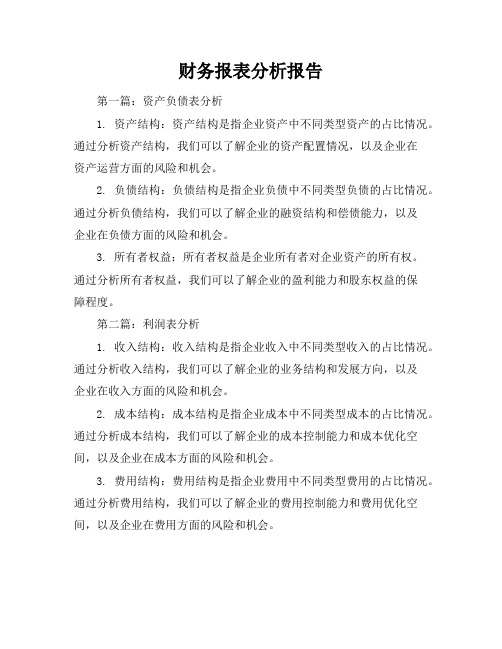
财务报表分析报告第一篇:资产负债表分析1. 资产结构:资产结构是指企业资产中不同类型资产的占比情况。
通过分析资产结构,我们可以了解企业的资产配置情况,以及企业在资产运营方面的风险和机会。
2. 负债结构:负债结构是指企业负债中不同类型负债的占比情况。
通过分析负债结构,我们可以了解企业的融资结构和偿债能力,以及企业在负债方面的风险和机会。
3. 所有者权益:所有者权益是企业所有者对企业资产的所有权。
通过分析所有者权益,我们可以了解企业的盈利能力和股东权益的保障程度。
第二篇:利润表分析1. 收入结构:收入结构是指企业收入中不同类型收入的占比情况。
通过分析收入结构,我们可以了解企业的业务结构和发展方向,以及企业在收入方面的风险和机会。
2. 成本结构:成本结构是指企业成本中不同类型成本的占比情况。
通过分析成本结构,我们可以了解企业的成本控制能力和成本优化空间,以及企业在成本方面的风险和机会。
3. 费用结构:费用结构是指企业费用中不同类型费用的占比情况。
通过分析费用结构,我们可以了解企业的费用控制能力和费用优化空间,以及企业在费用方面的风险和机会。
4. 利润水平:利润水平是指企业的盈利能力。
通过分析利润水平,我们可以了解企业的盈利能力和盈利增长情况,以及企业在利润方面的风险和机会。
第三篇:现金流量表分析1. 经营活动现金流量:经营活动现金流量是指企业主营业务产生的现金流入和流出。
通过分析经营活动现金流量,我们可以了解企业的主营业务盈利能力和现金流状况。
2. 投资活动现金流量:投资活动现金流量是指企业投资活动产生的现金流入和流出。
通过分析投资活动现金流量,我们可以了解企业的投资活动风险和机会。
3. 筹资活动现金流量:筹资活动现金流量是指企业筹资活动产生的现金流入和流出。
通过分析筹资活动现金流量,我们可以了解企业的融资能力和偿债能力。
第四篇:财务比率分析1. 流动比率:流动比率是企业流动资产与流动负债的比率,反映企业短期偿债能力。
英文财务报告分析(3篇)

第1篇Executive SummaryThis report provides a comprehensive analysis of the financial statements of ABC Corporation for the fiscal year ending December 31, 2022. The analysis covers key financial metrics, liquidity,profitability, solvency, and investment performance. The report aims to assess the financial health and performance of ABC Corporation and to provide insights for stakeholders and investors.1. IntroductionABC Corporation is a publicly traded company operating in the technology sector. The company specializes in the development and manufacturing of electronic devices and software solutions. The financial statements of ABC Corporation include the balance sheet, income statement, statement of cash flows, and statement of changes in equity.2. Financial Metrics2.1. RevenueABC Corporation reported total revenue of $5 billion for the fiscal year 2022, a 10% increase from the previous year. This growth can be attributed to the strong demand for electronic devices and software solutions in the market. The company's revenue from electronic devices increased by 12%, while software solutions revenue grew by 8%.2.2. Gross ProfitGross profit margin for ABC Corporation was 40% in 2022, slightly lower than the 42% recorded in 2021. The decrease in gross profit margin can be attributed to increased costs of raw materials and higher production expenses. Despite the decrease, the gross profit increased by 5% to $2 billion due to the increase in revenue.2.3. Operating ProfitOperating profit margin for ABC Corporation was 25% in 2022, a decrease of 2% from the previous year. The decrease in operating profit margincan be attributed to higher operating expenses, particularly in research and development and marketing. Despite the decrease, operating profit increased by 7% to $1.25 billion.2.4. Net ProfitNet profit margin for ABC Corporation was 20% in 2022, down from 22% in 2021. The decrease in net profit margin is primarily due to higher taxes and interest expenses. However, net profit increased by 5% to $1 billion.3. Liquidity Analysis3.1. Current RatioThe current ratio for ABC Corporation is 2.5, indicating a strong liquidity position. A current ratio above 1 indicates that the company has sufficient current assets to cover its current liabilities. The increase in the current ratio can be attributed to the increase in cash and cash equivalents, as well as the decrease in accounts payable.3.2. Quick RatioThe quick ratio for ABC Corporation is 1.8, which is also a healthy indicator of liquidity. The quick ratio, also known as the acid-test ratio, measures the company's ability to cover its current liabilities with its most liquid assets. The increase in the quick ratio can be attributed to the decrease in inventory levels.4. Solvency Analysis4.1. Debt-to-Equity RatioThe debt-to-equity ratio for ABC Corporation is 0.8, indicating that the company's debt is well-managed relative to its equity. A ratio below 1 suggests that the company has more equity than debt, which is a positive sign for investors and creditors.4.2. Interest Coverage RatioThe interest coverage ratio for ABC Corporation is 4.5, which indicates that the company has sufficient earnings to cover its interest expensescomfortably. This ratio is well above the industry average, indicating a strong financial position.5. Investment Performance5.1. Return on Equity (ROE)The return on equity for ABC Corporation is 20%, which is slightly lower than the 22% recorded in 2021. The decrease in ROE can be attributed to the increase in equity due to the issuance of new shares and the decrease in net profit margin.5.2. Return on Assets (ROA)The return on assets for ABC Corporation is 10%, which is in line with the industry average. This indicates that the company is utilizing its assets efficiently to generate profits.6. ConclusionThe financial analysis of ABC Corporation for the fiscal year 2022 indicates that the company is in a healthy financial position. The company has shown strong revenue growth, although there are concerns regarding the decrease in gross and net profit margins. The liquidity and solvency ratios are strong, indicating that the company hassufficient resources to meet its financial obligations. The investment performance metrics are in line with industry averages, suggesting that the company is managing its assets efficiently.Stakeholders and investors should be cautious about the decrease in profit margins and should monitor the company's ability to manage costs and increase profitability in the future. Overall, ABC Corporation appears to be a solid investment with potential for growth, but careful monitoring of financial performance is recommended.7. Recommendations- ABC Corporation should focus on cost management strategies to improve gross and net profit margins.- The company should continue to invest in research and development to stay competitive in the technology sector.- ABC Corporation should monitor its debt levels and ensure that they remain manageable relative to its equity.- The company should consider expanding into new markets or productlines to diversify its revenue streams.By implementing these recommendations, ABC Corporation can strengthenits financial position and continue to grow in the years to come.第2篇Introduction:Financial reporting is an essential aspect of any organization,providing stakeholders with a comprehensive overview of its financial performance and position. This analysis aims to evaluate a company's financial report, focusing on key aspects such as revenue, expenses, profitability, liquidity, and solvency. The report will be based on the financial statements of a fictional company, ABC Corporation, and will provide insights into its financial health and potential areas of improvement.Revenue Analysis:Revenue is a critical indicator of a company's ability to generate income. In the case of ABC Corporation, the revenue analysis reveals the following:1. Revenue Trend: Over the past five years, ABC Corporation has experienced steady revenue growth. This trend is evident in the increasing revenue figures year over year, indicating a strong market presence and customer base.2. Revenue Composition: ABC Corporation's revenue is primarily derived from its core business operations. The company has diversified its revenue streams by venturing into new markets and launching new products, contributing to the overall growth.3. Revenue Drivers: The analysis of revenue drivers reveals that the company's main revenue sources are its flagship product, followed by its new product line and international sales. The company's strategic focus on innovation and expansion has paid off, resulting in a robust revenue stream.Expense Analysis:Expenses are crucial in determining a company's profitability. The expense analysis of ABC Corporation is as follows:1. Cost of Goods Sold (COGS): The COGS represents the direct costs associated with producing the company's products. Over the past five years, ABC Corporation has experienced a slight increase in COGS, primarily due to raw material cost inflation. However, the company has managed to maintain a relatively low COGS percentage of revenue, indicating efficient production processes.2. Operating Expenses: Operating expenses, including salaries, marketing, and administrative costs, have shown a steady growth trend. This is a positive sign, as it indicates the company's investment in its workforce and market expansion. However, a detailed analysis of the individual components of operating expenses is necessary to identify any areas of concern.3. Interest Expense: ABC Corporation has a low level of interest expense, which is attributed to its conservative financing strategy. Thisindicates that the company is not heavily reliant on debt to fund its operations, reducing the risk of financial distress.Profitability Analysis:Profitability is a key measure of a company's financial performance. The profitability analysis of ABC Corporation is as follows:1. Net Profit Margin: The net profit margin, which measures the percentage of revenue that remains as net profit after all expenses, has shown a consistent improvement over the past five years. This indicatesthat the company is effectively managing its costs and generating a significant profit from its operations.2. Return on Assets (ROA): The ROA measures how efficiently a company utilizes its assets to generate profit. ABC Corporation has a relatively high ROA, indicating that it is generating substantial returns on its assets.3. Return on Equity (ROE): The ROE measures the return on the shareholders' investment. ABC Corporation has a high ROE, which is a positive sign for investors, indicating that the company is effectively utilizing its equity to generate profits.Liquidity Analysis:Liquidity is a measure of a company's ability to meet its short-term obligations. The liquidity analysis of ABC Corporation is as follows:1. Current Ratio: The current ratio, which compares current assets to current liabilities, is above the industry average. This indicates that ABC Corporation has sufficient liquidity to meet its short-term obligations.2. Quick Ratio: The quick ratio, also known as the acid-test ratio, measures a company's ability to pay off its current liabilities without relying on inventory. ABC Corporation has a strong quick ratio, indicating that it has ample liquidity to cover its short-term obligations without relying on inventory.Solvency Analysis:Solvency is a measure of a company's long-term financial stability. The solvency analysis of ABC Corporation is as follows:1. Debt-to-Equity Ratio: The debt-to-equity ratio measures the proportion of debt used to finance the company's assets. ABC Corporation has a relatively low debt-to-equity ratio, indicating that it is not overly reliant on debt financing and is well-positioned to meet itslong-term obligations.2. Interest Coverage Ratio: The interest coverage ratio measures a company's ability to pay interest expenses. ABC Corporation has a high interest coverage ratio, indicating that it has sufficient earnings to cover its interest expenses without financial strain.Conclusion:Based on the analysis of ABC Corporation's financial report, it is evident that the company is in a strong financial position. The steady revenue growth, improved profitability, and robust liquidity and solvency ratios are positive indicators of the company's overall financial health. However, it is crucial for the company to continue monitoring its expenses and maintain its conservative financing strategy to ensure sustainable growth in the long term.第3篇IntroductionThe annual financial report is a critical document that provides stakeholders with a comprehensive overview of a company's financial performance, position, and cash flows over a specific period. This analysis focuses on XYZ Corporation's 2021 annual report, examining key financial metrics, assessing the company's financial health, andoffering insights into its future prospects. The report covers aspects such as revenue, expenses, assets, liabilities, and cash flows, and evaluates XYZ Corporation's strategic decisions and market position.Revenue and Sales Analysis1. Revenue Growth: XYZ Corporation reported a total revenue of $5.2 billion in 2021, representing a 10% increase from the previous year. This growth can be attributed to the expansion of the company's product line, successful marketing campaigns, and increased demand for its services in the industry.2. Segment Analysis: XYZ Corporation operates in three main segments: Segment A, Segment B, and Segment C. Segment A contributed the highest revenue, accounting for 45% of the total, followed by Segment B (35%)and Segment C (20%). The growth in Segment A can be attributed to the introduction of new products and the expansion into new markets.3. Geographical Distribution: The company's revenue is evenlydistributed across its geographical markets, with no single region contributing more than 50% of the total. This indicates a strong presence and balanced growth across various regions.Expenses and Profitability Analysis1. Cost of Goods Sold (COGS): The COGS increased by 8% in 2021, reaching $3.4 billion. The increase in COGS can be attributed to the higher production costs due to inflation and increased raw material prices.2. Operating Expenses: Operating expenses increased by 6% in 2021, reaching $1.8 billion. The increase can be attributed to highermarketing and selling expenses, as well as increased research and development (R&D) costs.3. Net Profit: Despite the increase in expenses, XYZ Corporationreported a net profit of $1 billion in 2021, representing a 5% increase from the previous year. The company's strong revenue growth andefficient cost management have contributed to its profitability.Balance Sheet Analysis1. Assets: XYZ Corporation's total assets increased by 5% in 2021, reaching $8.5 billion. The increase in assets can be attributed to the acquisition of a new subsidiary and the expansion of its property, plant, and equipment (PP&E).2. Liabilities: The company's total liabilities increased by 3% in 2021, reaching $4.5 billion. The increase in liabilities can be attributed to the acquisition of the new subsidiary and the expansion of its credit facilities.3. Equity: XYZ Corporation's equity increased by 2% in 2021, reaching $4 billion. The increase in equity can be attributed to the net profit generated during the year and the repurchase of the company's shares.Cash Flow Analysis1. Operating Cash Flow: XYZ Corporation reported an operating cash flow of $1.2 billion in 2021, a 10% increase from the previous year. The increase in operating cash flow can be attributed to the company's strong profitability and efficient management of working capital.2. Investing Cash Flow: The investing cash flow was negative in 2021, totaling -$300 million. The negative cash flow was primarily due to the acquisition of the new subsidiary and the expansion of PP&E.3. Financing Cash Flow: The financing cash flow was positive in 2021, totaling $200 million. The positive cash flow was primarily due to the issuance of new debt and the repurchase of the company's shares.ConclusionXYZ Corporation's 2021 annual report demonstrates a strong financial performance, with revenue growth, profitability, and a healthy balance sheet. The company's strategic decisions, such as expanding its product line and entering new markets, have contributed to its success. However, the company faces challenges such as increasing costs and a volatile market environment. The analysis suggests that XYZ Corporation should focus on managing costs, diversifying its revenue streams, and maintaining a strong balance sheet to ensure sustainable growth in the future.Recommendations1. Cost Management: XYZ Corporation should continue to focus on cost management to offset the impact of increasing raw material prices and inflation.2. Diversification: The company should consider diversifying its product line and entering new markets to reduce its dependence on a single segment or region.3. Investment in R&D: To stay competitive in the market, XYZ Corporation should continue to invest in research and development to develop new products and improve existing ones.4. Debt Management: The company should carefully manage its debt levels to ensure that it maintains a strong financial position and can weather any future economic downturns.By implementing these recommendations, XYZ Corporation can continue to grow and maintain its position as a leader in its industry.。
accaf7知识点总结
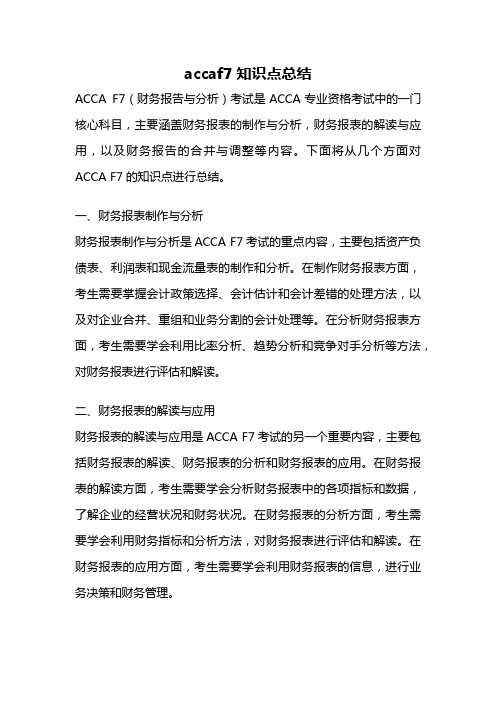
accaf7知识点总结ACCA F7(财务报告与分析)考试是ACCA专业资格考试中的一门核心科目,主要涵盖财务报表的制作与分析,财务报表的解读与应用,以及财务报告的合并与调整等内容。
下面将从几个方面对ACCA F7的知识点进行总结。
一、财务报表制作与分析财务报表制作与分析是ACCA F7考试的重点内容,主要包括资产负债表、利润表和现金流量表的制作和分析。
在制作财务报表方面,考生需要掌握会计政策选择、会计估计和会计差错的处理方法,以及对企业合并、重组和业务分割的会计处理等。
在分析财务报表方面,考生需要学会利用比率分析、趋势分析和竞争对手分析等方法,对财务报表进行评估和解读。
二、财务报表的解读与应用财务报表的解读与应用是ACCA F7考试的另一个重要内容,主要包括财务报表的解读、财务报表的分析和财务报表的应用。
在财务报表的解读方面,考生需要学会分析财务报表中的各项指标和数据,了解企业的经营状况和财务状况。
在财务报表的分析方面,考生需要学会利用财务指标和分析方法,对财务报表进行评估和解读。
在财务报表的应用方面,考生需要学会利用财务报表的信息,进行业务决策和财务管理。
三、财务报告的合并与调整财务报告的合并与调整是ACCA F7考试的另一个考点,主要包括子公司合并财务报表的制作和分析,以及关联交易和企业重组的会计处理。
在子公司合并财务报表的制作和分析方面,考生需要学会制作合并财务报表,了解合并财务报表中的关键指标和数据。
在关联交易和企业重组的会计处理方面,考生需要学会处理关联交易和企业重组的会计问题,了解其对财务报表的影响。
ACCA F7考试主要涵盖财务报表制作与分析、财务报表的解读与应用,以及财务报告的合并与调整等内容。
考生需要掌握财务报表的制作和分析方法,学会解读和应用财务报表的信息,了解财务报告的合并和调整的会计处理方法。
只有全面掌握这些知识点,才能在ACCA F7考试中取得好成绩。
希望以上内容对大家有所帮助。
acca资产负债表模板
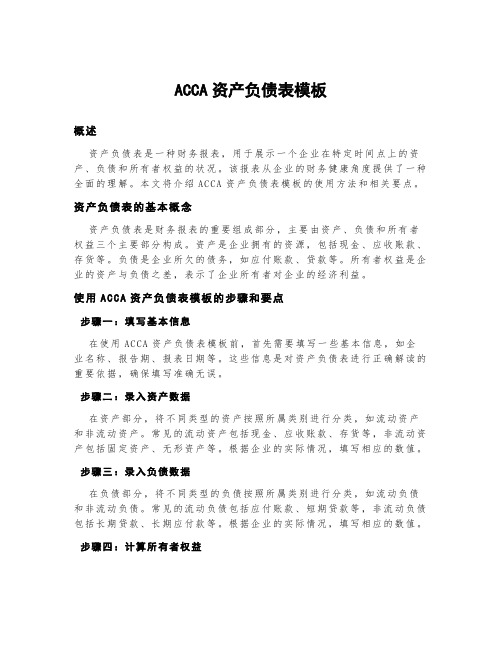
ACCA资产负债表模板概述资产负债表是一种财务报表,用于展示一个企业在特定时间点上的资产、负债和所有者权益的状况。
该报表从企业的财务健康角度提供了一种全面的理解。
本文将介绍AC CA资产负债表模板的使用方法和相关要点。
资产负债表的基本概念资产负债表是财务报表的重要组成部分,主要由资产、负债和所有者权益三个主要部分构成。
资产是企业拥有的资源,包括现金、应收账款、存货等。
负债是企业所欠的债务,如应付账款、贷款等。
所有者权益是企业的资产与负债之差,表示了企业所有者对企业的经济利益。
使用ACC A资产负债表模板的步骤和要点步骤一:填写基本信息在使用A CC A资产负债表模板前,首先需要填写一些基本信息,如企业名称、报告期、报表日期等。
这些信息是对资产负债表进行正确解读的重要依据,确保填写准确无误。
步骤二:录入资产数据在资产部分,将不同类型的资产按照所属类别进行分类,如流动资产和非流动资产。
常见的流动资产包括现金、应收账款、存货等,非流动资产包括固定资产、无形资产等。
根据企业的实际情况,填写相应的数值。
步骤三:录入负债数据在负债部分,将不同类型的负债按照所属类别进行分类,如流动负债和非流动负债。
常见的流动负债包括应付账款、短期贷款等,非流动负债包括长期贷款、长期应付款等。
根据企业的实际情况,填写相应的数值。
步骤四:计算所有者权益所有者权益是企业资产减去负债后的余额。
在AC CA资产负债表模板中,可以使用公式`所有者权益=资产-负债`来计算。
填写完所有者权益后,确保其与资产和负债两部分的数据相符。
步骤五:检查和调整在填写完所有数据后,需要对资产负债表进行检查和调整。
确认所有数据准确无误,进行合理性比较和分析。
如发现错误或不一致之处,进行必要的修改和调整。
资产负债表的重要性和应用场景资产负债表是财务报表中最基本且重要的部分之一,具有以下重要性和应用场景:评估企业财务状况1.:通过资产负债表,可以了解企业的资产结构、负债结构和所有者权益状况,从而评估企业的财务健康和稳定性。
acca中资产负债表和利润表科目

ACCA中的资产负债表和利润表科目概述ACCA(Association of Chartered Certified Accountants)是全球最具影响力的国际会计师组织之一,为会计和财务专业人士提供职业资格认证。
在ACCA考试中,资产负债表(Balance Sheet)和利润表(Income Statement)是两个重要的财务报表,反映了一个企业的财务状况和业绩。
资产负债表是企业在特定日期的财务状况的总结,以资产、负债和所有者权益的形式呈现。
利润表则是企业在一定期间内的业绩表现,展示了收入、费用和净利润等信息。
在ACCA考试中,了解和理解资产负债表和利润表的科目是非常重要的,下面将详细介绍这些科目。
资产负债表科目资产负债表科目主要分为资产、负债和所有者权益三个部分。
资产部分1.流动资产(Current Assets):指在一年内(或一经营周期内)能够变现或消耗的资产,包括现金、应收账款、存货等。
2.非流动资产(Non-current Assets):指超过一年(或一经营周期)的资产,包括长期投资、固定资产、无形资产等。
负债部分1.流动负债(Current Liabilities):指在一年内(或一经营周期内)需要偿还的负债,包括应付账款、短期借款等。
2.非流动负债(Non-current Liabilities):指超过一年(或一经营周期)需要偿还的负债,包括长期借款、长期应付款等。
所有者权益部分1.股本(Share Capital):指公司发行给股东的股份,代表股东对公司的所有权。
2.盈余公积(Share Premium):指公司以溢价发行股票所形成的资金,属于股东权益的一部分。
3.留存收益(Retained Earnings):指企业历年来未分配的利润,由于未分配给股东,属于企业自身的所有权益。
利润表科目利润表科目主要分为收入、费用和净利润三个部分。
收入部分1.营业收入(Revenue):指企业通过销售商品或提供服务所获得的收入。
accaf7考试内容是什么?F7考点解析

accaf7考试内容是什么?F7考点解析acca f7考试内容是什么?F7考点解析ACCA F7《财务报告》涵盖了财务会计、财务报表、公司合并报表、分析并解读财务报表等内容。
F7《财务报告》是对F3《财务会计》的延伸,也是SBR的直接基础。
通过学习F7,可以掌握如何运⽤会计准则和概念框架编制财务报表,分析并解读财务报表。
为了帮助⼤家应对考试,⾼顿⼩编(zgacca)给⼤家整理⼀些ACCA F7考试技巧:Section A(每题2分,共15题,),sectionB(共3道长题,每题5⼩题,共15题)。
在四⽉考官见⾯会中,考官介绍说section B的题⽬是计算与⽂字混搭。
每道⼤题中的五个⼩题相互不会有关联。
考官甚⾄⿎励考⽣先做简单⽂字部分。
个⼈预计sectionB会根据以前的⼤准则题进⾏改编,⽐如:flightline,Telepath,Shawler等都是曾经⽐较经典题⽬。
SectionA,B题⽬会覆盖整个syllabus,出镜可能⽐较⾼:■environmental provision满⾜capitalizedas PPE/intangible,求期末相关总expense(即depreciation+interest expense);■区分capital expenditure和revenue expenditure;■capitalization of planned overhaul expense;■repayment of government grant(两种⽅法下都必须掌握!);■capitalization of borrowing costs onqualifying asset(注意capitalization开始的时点是三个条件全满⾜后,若相关⼯作暂停,capitalization必须暂停,完⼯时capitalization终⽌,和资产有没有被使⽤⽆关。
interest income降低CV of asset必须发⽣在capitalization period);■PPE和investment property互转(特别是PPE转成investmentproperty以公允价值计量);■capitalization of development expense(重要考点!PIRATE满⾜前的expenses直接进⼊P/L,完⼯后开始计提amortization增加当期expense);■计算recoverable value(higher of FVLCOS and value in use)to decide the amount of impairment;■allocation of impairment in cash generatingunit(必会!);■reclassification requirements for NCAs heldfor sale and the definition of discontinued operation;■conceptual framework有可能考哪些treatments满⾜fair representation以及principle-based standard setting system的advantages;■区分change in accounting policy(recognition,presentation andmeasurement)and change in accounting estimate;■measurement of biological asset;■as sets outside the scope of IAS41;■finance lease obligation table(withdeposit,both payment in advance and in arrears),straight line amortization ofoperating lease expense with premium or incentive;■sale and finance lease back by using deferred income appro ach.■Five steps of recognizing revenue(specially variableconsideration,financing components and allocation of discount);■revenue recognized over time;■consignment sales(when the control of asset transferred to dealer);■sale and repurchase(essence=secu red loan);■bill and hold arrangement;■four steps of construction contract;■calculation of exchange profit or loss on monetary items;■EPS calculation under rights issue(注意rights issue bonus fraction的计算)and comparative EPS of previous year;■under full market issue combined with bonus(注意bonus fraction计算);■DEPs with convertible bond or share option(注意number offree shares的计算);■financial liability measured at amortized cost;■split of equity and debt elements of convertible bond(注意similar bond without conversion回报率⼀定会⾼);■measurement of financial asset;■factored receivable(如果坏账风险没有转移给保理⼈,则本质:secured loan);■合并报表,现⾦流量表和报表解析也会出现在section a特别是special organization 之ratio选择;■Group's profit or loss on disposal of subsidiary应该会出现在六⽉考试中!SectionC:如果是⾮合并报表就会搭配合并报表解析,反之亦然准备⾮合并报表:考官在今年四⽉见⾯会中指出考调整retained earnings或者当期net profit的可能性⽐考整个损益表的可能性⼤,剩下SFP或者SOCIE则会考整表。
- 1、下载文档前请自行甄别文档内容的完整性,平台不提供额外的编辑、内容补充、找答案等附加服务。
- 2、"仅部分预览"的文档,不可在线预览部分如存在完整性等问题,可反馈申请退款(可完整预览的文档不适用该条件!)。
- 3、如文档侵犯您的权益,请联系客服反馈,我们会尽快为您处理(人工客服工作时间:9:00-18:30)。
•
应付账款
•公司购买了$9,400的办公用品,未付款。 帐目发生了: (1) 存货 (资产) (2) 应付帐款(负债 )
•
应付账款
•公司购买了$9,400的办公用品,未付款
•
交易业务的分析
•下面为交易后出现的余额。注意资产负债表反映的是余额
•现在看交易中出现的收入和费用
•
收入
•咨询服务收入了$9,800 的现金. 帐目发生了: (1) 现金 (资产) (2) 收入 (权益)
•
•3 资产、负债和会计等式
交易对资产、负债和资本的 影响
交易对利润的影响 会计等式和经营等式 利润表和资产负债表的关系
•
独立于其所有者的会计主体
•资本:是指所有者想企业投入的资金
现金 投资组合计划
▪资本是获得回报为目的的投资。 ▪投入的资本是负债的一种形式。
•22
•
分析交易业务
1. 分析交易业务它的
•
英国会计的宏观管理:
对英国公司会计的制约和规范来自于两个方面: –《公司法》的有关规定 –会计专业团体制订的会计准则 会计职业团体协商咨询委员会
会计准则委员会
《标准会计实务公告》
会计准则理事会
《财务报告准则》
此外,上市公司还要遵守上市规则。
以上三者共同构成制约公司会计的“ 公认会计实务 ”。
•
ACCA财务报表分析报 告
•
授课重点:
▪ 在于提高企业管理者的财务分析能 力
▪ 在于对报表项目的理解与分析,而 不是会计核算
•
授课内容:
▪ 管理机构(宏观环境) ▪ 财务报表原则(会计核算原理) ▪ 财务报表的结构和内容(按项目加以解
释) ▪ 财务报表分析
•
制约财务报表编制的法规体系
•1
财务报表的法规环境 财务报告委员会 国际会计准则委员会 审计师的作用 “ 真实与公允”概念
来源.
2. 认定交易业务在会
计帐目中的方面.
也要认定交易业务在 财务报表中的位置
•
交易业务的分析
巴克成立了一个建筑咨 询公司。
分析下面的交易业务。
•
投资
•巴克投资了$50,000 在公司里并形成普通股
帐目发生了: (1) 现金 (资产) (2) 所有者权益 (权益)
•
投资
•巴克投资了$50,000 在公司里并变成普通股
▪ 审计师的作用就是检查和判断公司报表的编制是否 恰当.
▪ 审计师必须按照审计实务委员会(APB)制定和发布 的审计准则公告(statements of Auditing Standards)的要求进行审计。
▪ 审计师可以为企业的股东及其他信息使用者提供两 种类型的服务。
▪ 对公司的业务和报表进行内涵丰富的复核; ▪ 对报表的编制情况出具公平的意见。
•
购货
•购买货物付了$4,800 的现金。 帐目发生了: (1) 现金 (资产) (2) 存货 (资产)
•
购货
•购买办公用品货物付了$4,800 的现金。
•
购买设备
•公司购买设备付了$30,000 的现金. 帐目发生了: (1) 现金 (资产) (2) 设备 (资产)
•
购买设备
•公司购买设备付了$30,000 的现金。
▪ 负债:是对别人的欠款 例:银行贷款、银行透支款、欠供货的货款、欠 政府的税款
▪ 权益:所有者的资产的股份 例:普通股、留存收益
•
财务报表的使用者
▪ 对报表的需要: ▪ 为什么企业需要会计报表? ▪ 如果企业运行是有效率的,它为什么 还要编制财务报表?
•答案很简单。企业之所以需要生成信息来反 映其从事的经济活动,是因为有好几类“ 用户 群体”出于各种原 财务报表的另一目的是显示企业的财务状况 。
▪ 影响企业财务状况的主要因素有:
▪ 企业控制的经济资源 ▪ 企业的财务结构 ▪ 企业的流动性和偿付能力 ▪ 企业适应周边环境的能力
•
资产和负债
资产 = 负债 + 权益
▪ 资产:是企业拥有或控制的有价值的资源 例:现金、办公楼、厂房、设备、待售的库存商 品、原料
•
小型和中型规模公司
▪ 在编制报表方面,小型和中型规模公司可以 享受一些豁免
(但是,这并不意味着中 小型公司可以减免编制 报表的法律责任)
▪ 公司法给出了小型 和中型规模公司的定义
•
公认会计实务GAAP
• 公认会计实务(GAAP)是指制约企业会计 实践的各种规定。在英国将其成为“英国 的公认会计实务”(UKGAAP)
在英国,审计费是昂贵的,1997年对小 公司审计的有限豁免出台。从2000年7月 31日开始,如果公司的营业收入低于100
万英镑,就可以免除报表审计。
•
•2
财务报表的目标
会计主体 财务报表的目标 财务报表要素 财务报表的使用者 财务报表信息
•
财务报表的目的
财务报表的主要目的是提供有关会 计主体财务状况以及在给定期间内 财务运作情况的信息。
•
“ 真实与公允”(TFV)观点:
▪ 西方国家的法律在法学上一般分为两类:
–英美法系(少量的成文法,大量的判例法) –大陆法系(大量的成文法)
▪ 公司法没有给TFV下定义,认为只有遵守会计 准则和公司法,才算是显示TFV。
▪ 审计师负责对公司报表是否符合TFV进行审计 ,并发表意见。
•
小型公司的审计
•
会计主体
–以盈利为目的的经济组织 –独立于所有者(P24) –不一定是“ 法人”主体 –建立“ 簿记系统”
•
利润表
利润是收入大于支出所形成的差额 ▪ 企业的目的是为所有者赚取金钱。 ▪ 财务报表的目的之一是显示企业在一段时期
内经营的盈亏状况。 ▪ 利润表就是用来显示企业在给定时期内盈利
或亏损情况的报表。
公布的报表
•法定报表是法律 •规定公司必须按照
•一定格式对外 •公布的报表
•法定报表: • 利润表 • 资产负债表 • 董事会报告书 • 审计师向公司股东出具的审计报告 • 当一家公司有子公司时,还包括合并报表
•
会计准则的法律地位
▪ 会计准则并没有明确的 法律地位,法院也没有 明确其准确地位.但是, 广泛接受的观点是:会 计准则确实得到了法律 的支持。
• 英国的公认会计实务主要受下列因素制约 :
公司法(主要是1985年公司法) 会计准则; 主板证券市场的上市规定。
•
公认会计实务GAAP
▪ 公认会计实务还受其他一些非强制性因素的 影响,如:
▪ 国际会计准则 ▪ 欧盟部长会议颁布的“ 公司法指令” ▪ 其他国家的法律规定,尤其是美国
•
审计师的作用和“ 真实与公允观点” 的含义
